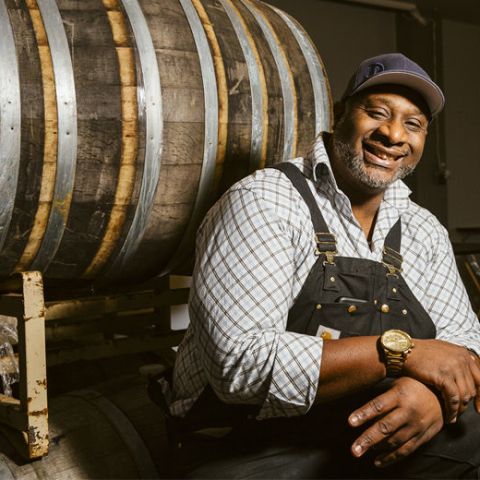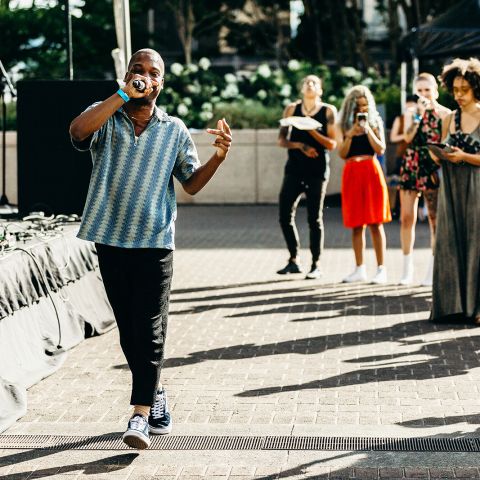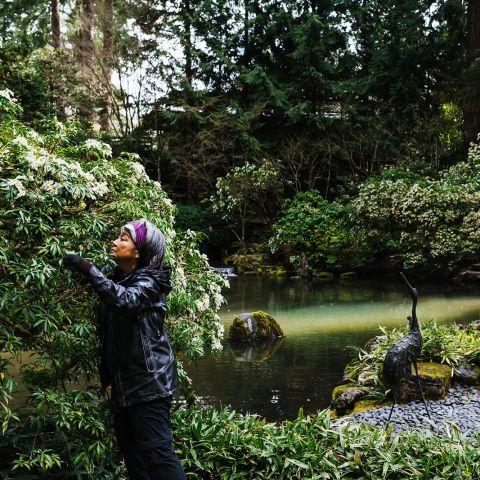
History
Delve into the roots of the Portland region.
To understand the history of Portland, Oregon, it is critical to look back to the original inhabitants of this region. Oregon’s population was largely Native American until relatively recently.
Pre-Portland History: Indigenous Peoples
The Portland metro area rests on traditional village sites of the Multnomah, Wasco, Cowlitz, Kathlamet, Clackamas, Bands of Chinook, Tualatin Kalapuya, Molalla and many other tribes. These groups created communities and summer encampments along the Columbia and Willamette rivers and harvested and used the plentiful natural resources of the area for thousands of years. The Indian Removal Act of 1830 and Oregon Donation Land Act of 1850 forcibly removed these tribes and offered free land to white settlers, who quickly laid claim to 2.5 million acres of tribal land, including all of what is now Portland. It is a testament to the resiliency of Indigenous peoples that Portland’s urban Native community now includes nearly 70,000 people from nearly 400 tribes. Many artifacts of Northwest tribes are on display at Portland Art Museum’s Center for Native American Art, and the region is home to numerous Native makers, artists, businesses and cultural sites.
Fur Trade and the Oregon Trail
The global interest in the North American fur trade preceded the arrival of the Pilgrims, and European traders relied heavily upon native people to “provide furs and hides as well as food, equipment, interpreters, guides, and protection.” By the early 19th century, fur trading had made its way to what is now Oregon. Shortly after Lewis and Clark led their historic expedition along the Columbia River, New Yorker John Jacob Astor founded the Pacific Fur Trading Company in 1810 and set an expedition to establish Fort Astoria in what is now Astoria, Oregon. In 1825, the British Hudson’s Bay Company established a fur-trading camp at Fort Vancouver, across the Columbia River from modern-day Portland. The camp was helmed by John McLoughlin, whose historic home in Oregon City is now part of the national park system, as is a complete replica of the fur-trading camp in Vancouver, Washington.
White colonizers began to establish settlements along the Willamette River between what we now know as Oregon City and Fort Vancouver as more people traversed the 2,170-mile (3,490 km) Oregon Trail to seek better opportunities after the economic downtown of the 1830s. The trail ended south of Portland, where today you can find and explore the End of the Oregon Trail Interpretive Center. Between 1840 and 1880 as many as 500,000 travelers traveled the Oregon Trail, some staying in Oregon, while others ventured south to California or north to Washington.
From Stumptown to Portland
Frequented by traders and settlers in the 1830s and 1840s, the future city of Portland became known as “Stumptown” as the thick forest of fir, cedar, hemlock and maple trees was cleared for growing settlements. The city was officially founded in 1843 and its name was famously determined by an 1845 coin toss between business partners Asa Lovejoy (of Boston, Mass.) and Francis Pettygrove (of Portland, Maine). You can see the “Portland Penny” that decided the city’s fate at the Oregon Historical Society in downtown Portland. In addition to showcasing memorabilia, the Oregon Historical Society challenges conventional thinking around Oregon’s past with its research facility, library of Oregon history and innovative exhibitions.
As settlers displaced the Indigenous tribes and redefined the riverside landscapes, the founders of the Oregon Territory began to shape it as a “white utopia.” Founded on principles of white supremacy, Oregon has a longstanding racist past; from the land grants enticing white settlers and their families to follow the Oregon Trail from the Midwest, to constitutional laws forbidding Black Americans from residing and owning property in or even traveling through the state. In 1844, the Oregon Territory government passed a law banning slavery and requiring all African Americans in Oregon to leave the state. Five years later, in 1849, another law made it illegal for African Americans to even enter Oregon. Oregon was built on exclusion, with legislation in place at its statehood in 1859 that made it illegal for Black Americans to visit, own property or live in the state. Though these laws were superseded by federal laws in the 1860s – with the passing of the Thirteenth, Fourteenth and Fifteenth amendments to the Constitution – Oregon did not ratify some of these amendments until 1959 (Thirteenth Amendment) and 1973 (Fourteenth Amendment). Oregon made it clear that Black people and people of color were not welcome, something that is reflected today in the relatively small percentage of Black and BIPOC residents of Portland and Oregon. In Portland, exclusionary laws extended to land and home ownership in 1919, when the Realty Board of Portland approved a Code of Ethics forbidding realtors and bankers from selling or giving loans to minorities for properties located in white neighborhoods, a practice known as “redlining.” As Portland grew and attracted immigrants, these policies limited their opportunities to thrive and build generational wealth in the city.
Sailors and Shanghai Legends
In the 19th century, Portland rapidly grew into a bustling port town and earned the reputation of “one of the most dangerous port cities of the West Coast.” Hundreds of sailors passed through the port daily, visiting the many saloons, bordellos, gambling dens and boarding houses. The Old Portland Underground stretched beneath the streets of Old Town and is still partially intact today. These passages, infamously known as the Shanghai Tunnels, were built to move goods from the docks on the Willamette River to the basements of hotels and businesses. However, more colorful –and disputed– stories exist about their true purpose.
Chinese and Japanese History in Portland
Old Town is aptly named since much of Portland’s early construction was nestled in this area north of present-day downtown Portland. While a fire gutted the town in 1873, you can still see the oldest standing buildings and even the earliest public artwork – the Skidmore Fountain, built in 1888 – in Old Town Chinatown today. Portland’s Chinatown Gateway, built in 1986, pays homage to the Cantonese-Chinese immigrants who came to Portland working the railroads or mining for precious metals in Eastern Oregon. In 1885, Portland’s Chinatown was home to the largest population of Cantonese-Chinese outside of San Francisco and Vancouver, B.C. Old Town was also home to one of two Japantowns in Portland. Japanese immigrants worked as farmers, loggers and business owners, establishing over 100 businesses. These businesses within Chinatown and Japantown, hotels, tailors, dentists, doctors, general stores and more, offered services to other Japanese and Chinese residents, as well as to retirees and pensioners who sought affordable living in Old Town. The Chinese Exclusion Act of 1882 made Chinese immigration to the United States illegal, and, in 1942, Americans of Japanese ancestry were sent to concentration camps following the attack on Pearl Harbor. The U.S. government imprisoned 3,676 Japanese Americans from Oregon and southwest Washington at the Pacific International Livestock Exposition Center, now known as the Portland Expo Center. When WWII ended, many Japanese and Chinese Portlanders made their way back to Portland but found it difficult to re-establish their businesses amid persistent racism. While Old Town Chinatown is no longer the economic center for Portland’s Chinese or Japanese populations, it houses several important cultural destinations, including the Japanese American Museum of Oregon, Portland Chinatown Museum and Lan Su Chinese Garden. Today, Southeast Portland’s Jade District is home to many Asian-American businesses, including stellar restaurants and groceries.
The City Grows
Outside of Old Town, wealthy landowners were buying large parcels of land and the city’s development began to take shape. One such influential landowner was Henry Pittock, who took over The Oregonian in 1860, “the oldest continuously published newspaper on the U.S. west coast.” Beyond the paper, Pittock invested in real estate, railroads, steamboats, sheep ranching and silver mining. An avid lover of the outdoors, Pittock located his mansion atop the West Hills adjacent to Forest Park, with breathtaking views of the city below and Mount Hood in the distance. The estate originally spanned 46 acres (18.6 hectares), with the mansion and grounds designed with views in mind. Pittock loved to hike and, today, many visitors hike the Wildwood Trail to reach the historic, 16,000 square-foot (1,486 sq m) mansion, which opened as a museum in 1965. Its 23 rooms boast the latest (of the time) modern comforts such as a refrigerator room, central heating, electric lighting and an elevator, all in a French Renaissance chateau style.
The Bridges of Portland
As a riverside town, Portland is known for its bridges. Twelve bridges span the Willamette River with eight walkable bridges connecting the city’s west and east sides. In 1912, the Steel Bridge was rebuilt (replacing its 1888 predecessor – made entirely of steel and the first bridge in the city) as a double-deck, swing-span bridge. Carrying horse-drawn carriages in 1888 and an electric streetcar in 1889, the Steel Bridge today isn’t far from its roots. With cars and light rail trains on the upper deck, bicyclists and pedestrians cross the river alongside rail cars on the lower deck. The Hawthorne Bridge, built in 1910 to replace the Madison Bridge which was destroyed by a fire in 1902, is the oldest vertical-lift bridge still in operation in the United States. More recently, Portland made history again with the Tilikum Crossing, Bridge of the People. Opened in 2012, the Tilikum Crossing is the first of its kind, a bridge open only to pedestrians, bikes and public transit. Many walk or bike it as part of the loop trail from the Vera Katz Eastbank Esplanade to Tom McCall Waterfront Park, and enjoy its LED light display at night.
Walkable Historic Bridges
A great way to see Portland is while crossing one of the city's iconic bridges.
Eastside Evolution
Before the construction of any of Portland’s notable bridges, James B. Stephens established the Stark Street Ferry in 1848 using a mule on a treadmill to power the boat’s paddle wheel and connect the east and west sides of the Willamette River. Though the marshy, riverside terrain of the east side made it expensive to develop, the settlement of East Portland grew rapidly with the Oregon Central Railroad establishing in 1868 a line that stretched south to Salem. By 1870, Stephens incorporated the City of East Portland with a population of 8,293. It had over 11,000 residents by 1891, when East Portland, Portland and Albina merged, becoming the city of Portland. At the same time, William S. Ladd’s 126-acre (51 ha) farmland, which sat between Stephens’ and Gideon Tibbetts’ land claims, became the first residential neighborhood in Portland – Ladd’s Addition – and one of the oldest planned residential developments in the Western states.
Ships and Steam Locomotives
Moored along Waterfront Park, the “Portland” sternwheel tugboat houses the Oregon Maritime Museum. Inside the last steam-powered tugboat built in the United States, you can tour the pilothouse and engine room, and explore displays about Portland’s maritime history. The port wasn’t the only way goods were moved to this new town. Union Pacific Railroad made its way to Portland at the turn of the 20th century, and by 1935 launched the first streamliner between Chicago and the Pacific Coast. You can view three of these vintage steam locomotives at Oregon Rail Heritage Center in Southeast Portland.
Black Main Street and Gentrification
As in other cities and states across the United States, the practice of redlining (denying majority Black and lower-income neighborhoods vital services such as housing, health care and even food), created a huge disparity in land ownership in Portland. These practices made it difficult for non-white families to have safe and stable housing in Portland. Under the guise of “urban renewal,” Portland decimated Albina, the majority Black neighborhood in North Portland, beginning in 1956 with the razing of land to build what is now the Rose Quarter, pave Interstate 5 and Highway 99 through the growing central city and expand Legacy Emanuel Hospital which displaced over 300 Black-owned homes and business at North Williams and Russell Street, once known as Portland’s “Black main street.” As the city continues to gentrify, many Black families continue to be displaced. Organizations such as Albina Vision Trust, Historic Black Williams Project and Urban League of Portland are working tirelessly to give voice and agency to the communities that Portland has traditionally oppressed.
Black Community
Support Black-Owned Restaurants in Portland
Brought into focus by local organizations, explore the city’s diverse and delicious Black-owned food carts, restaurants and markets in Portland.
Meet Bertony Faustin, Oregon’s First Black Winemaker
Oregon’s first Black winemaker, Bertony Faustin, has been building community since 2007 when he launched his small-batch winery, Abbey Creek.
The Portland Hip-Hop Scene
Take a deep dive into the past, present and future of the Portland hip-hop scene with our expert guide to the best rap artists, showcases, shops and more.
Vanport and Its Legacy
The roots of another disappeared community can be found near Smith and Bybee Wetlands. In 1942, a WWII shipyard called Vanport was built in 110 days. The Vanport housing project for the workers and their families swiftly became Oregon’s second-largest city, with 40,000 people living there at its peak. As many as 40% of Vanport residents were Black, and the shipyard contributed to the growth of Oregon’s Black population from 2,000 to 20,000 residents. After the war, many families remained in this multicultural city, unable to find other homes due to discriminatory housing laws. A historic flood on Memorial Day in 1948 broke through the nearby levees, destroying the entire city in a day and displacing the 10,000 remaining inhabitants into Portland neighborhoods. The history of Vanport and its residents are illuminated by Vanport Mosaic, a local nonprofit, which hosts historical lectures and performances. The annual Vanport Jazz Festival commemorates the Black community and the legacy of jazz in Portland.
Was this page helpful?





